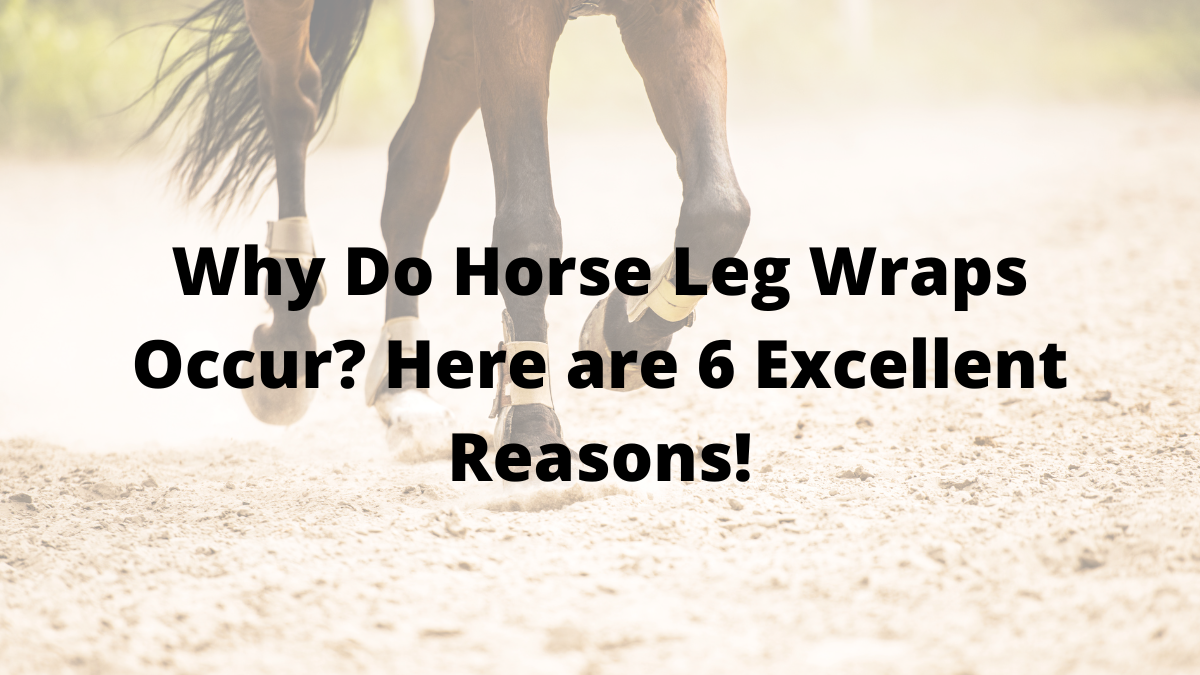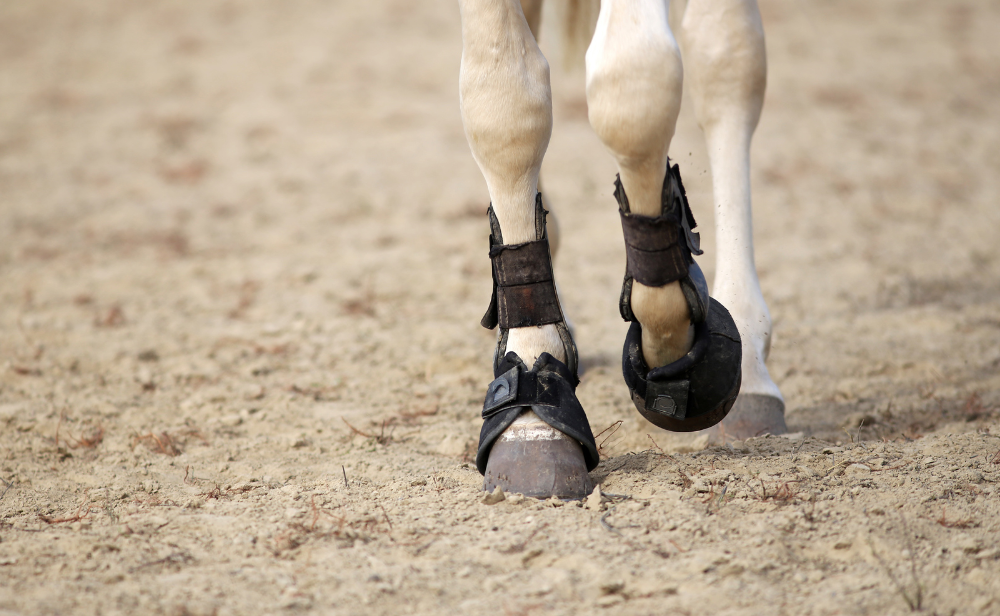Why Do Horse Leg Wraps Occur? Here are 6 Excellent Reasons!


If you watch horse racing, you’ve probably seen that some horses gallop with their legs wrapped while others do not. Have you ever considered the purpose of horse leg wraps?
Horse leg wraps provide support for the tendons and ligaments and guard against interference and rundown injuries. They are occasionally placed on a horse only to add a little flair, but they are also used to cover wounds and keep flies off of horses’ legs.
Horses use wraps for various purposes that most bystanders are unaware of. Using leg wraps on a horse is a decision that requires careful consideration.
Application of horse leg wraps
Leg wraps come in a range of designs and applications. Some wraps are intended to be worn while exercising while being transported, while using a stall or a small paddock, or while the animal is injured.
It would help if you had an expert show you how to properly wrap a horse’s leg before you use wraps for the first time. Inadequate limb wrapping can cause catastrophic damage to your horse.
Leg wraps are a tool for injury prevention.
Leg ties are not required for a horse race. Sport horses can run with wraps on any or all of their legs, occasionally even without any wraps. Does this provide any information regarding the horse’s health? No, the trainer decides typically based on their experience.
I am aware of some trainers who wrap the rears of every horse under their charge. I also observe other trainers who like to avoid placing anything on their horses’ legs until required.
Back leg wraps
Racehorse trainers frequently apply “rundown bandages” to their horses’ hind legs. Friction abrasions and interference injuries are avoided by using rundown bandages.
When horses fall over during a race, their fetlock area hits the ground and creates friction, resulting in rundown abrasions. Rundown abrasions can happen to horses racing on deep tracks or with lengthy pasterns.
The area around the back fetlock is covered with felt-based speciality pads to prevent rundown abrasions. Vet Wrap is a flexible, self-adherent bandage used to secure the cushions.
Rear legs also provide defence against quick scalping and cutting. A special kind of interference harm is shortcuts.
Scalping and cutting quickly,
“Speedy-cuts” happen when the front leg’s foot strikes the back portion near the knee or hock as opposed to the fetlock. Horses who sprint often get severe cuts because the shoe toe acts like a knife on the delicate tissue of the touched leg.
Rapid cuts can cause significant tendon injury and lacerations. Scalping and swift cuts are frequently used interchangeably, although they should only be performed when the forefoot makes contact with the coronet band of the hindlimb.
Front leg edging
A racehorse’s front legs are routinely wrapped to prevent interference injuries and to maintain the tendon. When a horse is running, interference injuries can occur when one limb collides with another.
For various reasons, including conformation, inadequate fitness, inappropriate shoeing, or the horse’s stride mechanics, horses’ legs are struck. A healthy horse could stumble during a race and collide its legs with one another, injuring itself.
Injuries from interference
An interference injury can cause anything from rubbed hair to a significant cut in severity. Interference injuries, especially those that affect the fetlock joint region, can result in bruising, discomfort, and oedema.
Brushing
When opposing limbs come into contact with one another, an interference injury known as brushing happens. The communication between the horse’s foot and the front limbs typically starts at the knee. The fetlock region of the back legs is usually where the strike occurs.
Although some horses’ contact reduces at faster speeds, interference generally tends to rise with the variety in the horse’s turnover rate. Therefore, it doesn’t appear that higher speeds and high strikes are related straightforwardly.
Overreaching
When a horse overreaches, the toe of the hind foot makes contact with the lower back of the front limb. The racehorse may sustain significant injuries and experience downtime from a blow to this location.
Overreach injuries frequently snag the back of the front foot’s shoe or shred the heel bulb. On the lower limb, bruises and scrapes often happen. They can be severe or minor.
Forging
Forging injuries are a sort of interference injury. Therefore I included them for reference even though they can’t be treated with bandages. Forging happens when the rear toe contacts the horse’s front foot’s sole, typically just after the front foot lifts off the ground.
Tendon support is provided via leg wraps.
According to some trainers, Wraps provide additional support for the horses’ tendons when they run. However, this has not been proven to be accurate by studies. However, they do aid in supporting tendons that are frail or have had injuries.
It’s critical to understand that a horse’s legs get hotter when wearing leg wraps. Both positive and negative effects may result from this. A veterinarian may occasionally suggest heat therapy for tendon injuries, although this is not always the case.
How long should standing wraps be left on a horse?
Your horse’s legs should not have standing wraps on them for an extended period of time without being taken off and rewrapped. Usually, I don’t leave them on for longer than 12 hours. However, I am aware of several persons who change their without incident every day.
Wounds are frequently covered with leg wraps.
No matter how careful we are, horses nevertheless suffer injuries. It’s frequently advisable to treat the wound, cover it with gauze, and wrap its leg when they cut its lower legs.
When hauling, are horse leg wraps used?
For a few reasons, it would be preferable if you wrapped your horses’ legs when pulling the animal. Horses must be in motion, or their legs may bulge. Horse leg wraps apply pressure that promotes blood flow and decreases oedema.
To prevent severe damage, wrapping a horse’s legs while it is being transported is advisable. The animal is being moved around by a trailer and is therefore prone to make a mistaken step that could injure it. Leg wrapping offers a defence against this.
The length of the shipping wraps should extend from the top of the pastern to the coronary band. Shipping boots are an alternative to most wraps for protection against acute wounds.
Pests are kept off a horse’s legs with horse leg wraps.
An endless battle with flying insects surrounds a horse barn. The entire body of the horse, especially the legs, is aggravated by these bugs. Some horses will strike the ground with their foot to keep horseflies away.
The repeated foot pounding can damage a horse’s legs even if it may seem like a good idea to strike the ground to keep pests off their legs. You can wrap the legs of these critters to stop them from bothering your horse.
Horsefly protection is provided explicitly by special boots and coverings. However, conventional standing wraps work just nicely for wrapping their legs.
Leg wraps make a horse look better.
Although winning is usually the only thing that matters in horse competitions, looking well is still acceptable. Some trainers go above and beyond to make their horses stand out. They dress up their horse’s appearance with chic braiding and vibrant wraps.
Many trainers believe it is not worth the danger to use extraneous equipment. Some horses find wrapped legs irritating; if not used properly, they may come loose in the middle of a race.
Many kinds of horse leg wraps
Horse leg wraps come in two main varieties, each with a specific function.
Polo wraps: When competing or working out, these wraps are often used for support.
Stable wraps, also known as standing wraps, apply pressure, cure wounds, support tendons, and relieve swelling. Standing wraps have two layers: an outer bandage that holds the inner layer in place and an inside layer of padding made of thick quilted fabric that helps disperse pressure.





